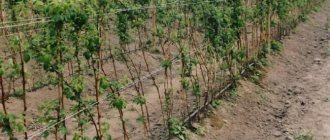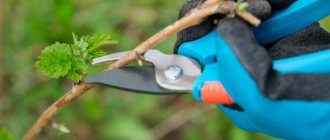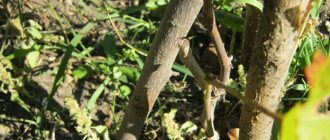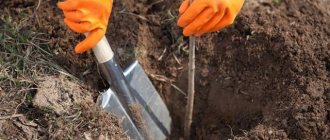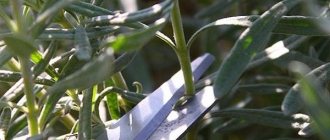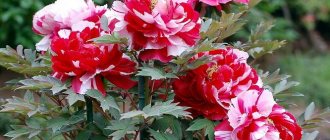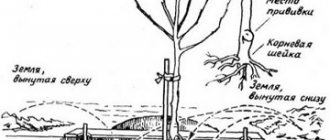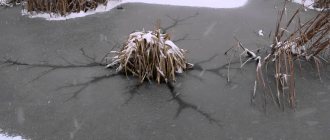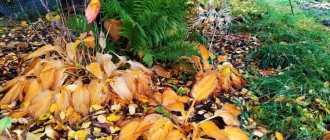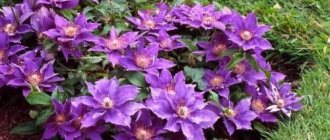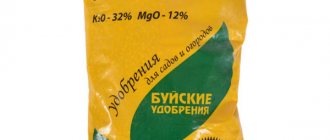Caring for raspberries in the fall begins immediately after harvesting the last fruits. This process is well known to experienced gardeners, but beginners may have questions. Do the branches need to be trimmed? Is it worth feeding and covering raspberries? All these are fundamental problems that determine exactly how well the raspberries in the garden will restore strength and prepare for fruiting for the next season.
Dear readers! For you, we have created communities on social networks in which useful articles and interesting ideas are published several times a day! Subscribe and receive useful content in a convenient format!
How to prepare raspberries for winter
Preparing raspberries for winter is by no means a difficult task. In many ways, all the steps are standard and equally acceptable for most garden crops. Actions required at the end of the season: pruning, fertilizing, mulching. But each of them has its own subtleties.
A complete plan for preparing raspberries for winter includes the following steps:
- After harvesting the last harvest, raspberries need to be pruned. Old and diseased branches are precisely removed.
- Ideally, treat all bushes against diseases and pests as a preventive measure for the next season.
- Organize sufficient watering if the autumn is dry.
- Dig up the raspberry patch and apply fertilizer.
- Sprinkle the roots with mulch and, if necessary, cover the area for the winter.
Of course, it is possible to achieve a harvest without such comprehensive, sensitive care. But, if we are talking about the desire to get a good harvest in the future, then you will have to monitor the raspberries more carefully.
How to grow more crops?
Any gardener and summer resident is pleased to receive a large harvest with large fruits. Unfortunately, it is not always possible to obtain the desired result.
Plants often lack nutrition and useful minerals
It has the following properties:
- Allows you to increase yield by 50% in just a few weeks of use.
- You can get a good harvest even on low-fertility soils and in unfavorable climatic conditions
- Absolutely safe
Pruning raspberries in autumn
Pruning raspberries
Pruning raspberries every fall is absolutely necessary . The quality of berries in the future greatly depends on this stage. If you leave old and diseased branches throughout the winter, then in the spring they will use nutrients from the soil, “eating” the best shoots. As a result, the entire harvest will become worse.
Which varieties need to be pruned?
It is recommended to prune raspberries in the fall in any case. The only question is how much to thin out the bushes.
For example, complete pruning at the root will greatly rejuvenate the entire raspberry tree, but the harvest in the spring will be poorer (though of high quality) and only at the very end of the next season.
It is more effective to trim the raspberries partially, leaving the strongest shoots . In this case, ordinary varieties will bear fruit of the same quality year after year, and remontant varieties in good conditions can even produce two harvests the following summer and autumn.
Why is this procedure performed?
If you don’t trim the raspberries at all, then the entire area begins to be actively overgrown with old and new shoots. First of all, this leads to the wilding of the crop, the formation of small berries with a large number of “seeds”.
Secondly, bushes without pruning are tasty morsels for pests and viruses, where harmful organisms find excellent shelter from rain, sun, wind and other unfavorable factors.
Finally, an unkempt raspberry tree is more difficult to maintain. In dense areas it is difficult to control weeds and pests, as well as pick berries.
Pruning woody and diseased shoots
How to choose the time for pruning?
It is difficult to find the same timing for pruning raspberries. However, you can be guided by the following principles:
- You can prune the bushes immediately after the last berry picking. Usually this is the end of August, mid-September.
- Or postpone pruning until later. The main thing is that there should be at least 3 weeks before the onset of sub-zero temperatures during the daytime.
- Remontant raspberries bear fruit until late autumn, which is why they are pruned very late, when the bushes shed almost all their foliage.
How to properly prune raspberries in the fall. Step by step instructions
The procedure for pruning raspberries before winter should be approximately as follows:
- First of all, cut off diseased branches (then burn them with the rest of the debris).
- Get rid of broken or dry shoots.
- It is advisable to prune two-year-old shoots that have already had several harvests.
- Not necessary, but it won't hurt to get rid of thin and weak shoots.
- The strongest branches also need to be shortened, but by about a quarter of the length .
Pruning 2-year-old shoots
The branches should be cut at the root, but try not to leave their visible parts above the ground, otherwise this place will become ideal for overwintering pests. You can even dig up the raspberries a little at the base, cut off the necessary branches, and then cover them with soil again.
The basic rule: per 1 m2 of raspberry tree before winter there should be 8, maximum 10 branches.
By the way, we recommend trimming raspberries with a clean tool with disinfected blades.
Features of pruning remontant raspberries
There are no big peculiarities in pruning remontant raspberries. In fact, every gardener must choose for himself:
- To get one, but powerful, healthy, tasty harvest, you should trim remontant raspberries at the root.
- If you need two harvests (with a drop in the quality of the berries), then the raspberries are partially pruned. You need to remove old, dried shoots, and leave the strongest and youngest ones.
What is double trimming?
Double pruning of raspberries is an experimental method that has received attention due to a significant increase in crop yield. The essence of the method is that young raspberry shoots are cut to 15-20 cm in length. In the spring, when they reach a height of 30 cm, their tops are cut off or pinched. Thus, it turns out to “thicken” the raspberry tree, awakening dormant buds, increasing the number of side shoots.
As a rule, the method is applied consistently for several years. However, some gardeners fit the technique into one season. To do this, the first pruning is carried out before winter, and the next one at the beginning of summer.
Scheme for double pruning raspberries
Double pruning method to improve wintering of raspberries
Experienced gardeners use various methods to increase the fruitfulness of the garden, including preparing crops for frost. There is a method of double pruning the plant that improves yield and prepares the plant for harsh cold days. Its essence is to shorten the tops of the shoots to 1 m in early spring and autumn.
During autumn pruning, it is necessary to leave a few branched branches for overwintering. The strongest of them, which remain vital until spring, after opening are pruned again in the upper third, only now not the main stem, but the lateral ones that have grown. In this way, excessive density and tangles are prevented, the correct shape of the bush is formed and there is no need to make large distances between rows.
Strict adherence to the established rules for preparing plantings for the frosty months will ensure reliable preservation of the stems and high yields in the coming season. The whole procedure does not require much time and financial costs.
What should you do after pruning?
Pruning is very stressful for any plant. Feeding and abundant watering will help reduce its influence.
It is better to fertilize raspberries immediately with mixtures with potassium or phosphorus - this will help the crop begin preparing for the winter season and increase the frost resistance of the roots.
To prevent trimmed raspberries from becoming a target for pests, they can be sprayed with Bordeaux mixture at the same time.
Finally, later there will be only one necessary step left - mulching. For regions with cold winters, a step may be added with the obligatory covering of the raspberry tree with leaves, straw or cloth to protect it from severe frosts.
How to feed raspberries in the fall, features of autumn feeding
Another important stage that no experienced gardener skips is the mandatory feeding of raspberries in the fall. This is done in order to restore the balance of nutrients in the soil, which is greatly depleted during the period of raspberry fruiting.
- An important feature is that you need to focus on potash and phosphorus fertilizers . Potassium accumulated in the plant has a beneficial effect on frost resistance. Phosphorus, in turn, will strengthen the root system and also contribute to better wintering of raspberry bushes.
- But fertilizers containing nitrogen should definitely be excluded. Nitrogen, on the contrary, promotes increased plant development, which is harmful before winter.
Adviсe . The lack of certain fertilizers can be determined by the appearance of the raspberries. The leaves at the base become reddish when there is not enough phosphorus. With a lack of potassium in the leaves, marginal necrosis begins - drying out of part of the leaf blades, usually along the edges.
Lack of nutrients
Most often they resort to fertilizing raspberries with potassium monophosphate (proportion: 40 g per 1 m2), since the product contains both potassium and phosphorus . You can give preference to superphosphates (the proportion is the same), potassium sulfates (20 g per 1 m2). It is advisable to carry out such fertilizing every year , removing all weeds in front of them and cutting off unnecessary shoots in advance. It is better to sprinkle dry fertilizers with soil.
Once every 3-4 years you need to apply organic fertilizers to the area where the raspberries grow. Compost or humus is suitable (about 5 kg per 1m2).
Note : it is better not to feed one-year-old raspberry seedlings before winter (since it is more correct to apply fertilizers at the time of planting, and this will be enough). Very young (1-2 years) bushes are fed with weaker doses.
Features of feeding different types of raspberries
All varieties and raspberry-blackberry hybrid varieties of raspberries require basic nutrition and additional feeding:
- organic fertilizers are applied to the soil before planting;
- the soil is also limed before planting;
- nitrogen is necessary for the development of shoots, potassium and phosphorus - for abundant fruiting;
- mineral complexes are used directly when planting bushes;
- subsequently, organomineral mixtures are used as root fertilizers.
Feeding remontant raspberries
Remontant raspberries have become popular among gardeners in recent years. Autumn pruning of individual fruit-bearing shoots and pruning of annual branches is not necessary .
The peculiarity of cultivation is quick and easy care after harvesting; the above-ground part is completely mowed.
Reference. Remontant raspberries are special varieties (Heritage, Diamond, Primara) of the crop that bear fruit on annual and biennial shoots.
This species bears fruit only at the end of summer. It is characterized by high yields and resistance to pest damage.
In mid-summer, the raspberry plant experiences a deficiency of nutrients - the plant blooms and berries form. During this period, it is important to feed the bushes with mineral fertilizers. Experienced gardeners use complex mixtures to ensure high yields.
Recipe for Green solution for foliar treatment of raspberries
The mother liquor is diluted in 2-2.5 liters of hot water:
- metal utensils are not used due to copper-containing preparations;
- Dissolve 50 g of iron sulfate in hot water;
- add 100 g of copper sulfate;
- 10 g of citric acid (to convert iron into chelate form);
- 100-150 g of dry pressed yeast, can be replaced with the drug Rostmoment, 100 g, based on yeast - a growth and development regulator;
- organomineral fertilizer Fitaktiv Vita, a powerful concentrate, NPK-complex with microelements and vitamins, add according to the instructions in proportions per 12 l; can be replaced with another complex liquid fertilizer, for example, Belvito.
The working solution is prepared based on 12 liters of water:
- Bring the mixture to 12 liters of water;
- to stir thoroughly;
- store the prepared solution for 5-7 days in a cool place without access to direct light;
- The green mixture gradually gives a precipitate (iron and copper phosphates, yeast), stir the solution immediately before processing;
- When using a sprayer, strain the mixture.
Raspberries are processed during the flowering period, at the beginning of fruiting.
Complex effects of the Green mixture:
- prevention of infectious and viral diseases during the active growth stage of the culture (chlorosis);
- fungicidal treatment against fungal infections (purple spotting);
- insecticidal effect, the repellent solution serves as a repeller of harmful insects; at the same time, it is safe for raspberry pollinators (bees, bumblebees);
- parallel introduction of mineral compounds - nutrition, activation of protective functions and strengthening of phytoimmunity;
- yeast – hormonal stimulation of growth, flowering, absorption of mineral components;
- safe composition (without heavy chemicals) ensures a healthy harvest without harm to health and the environment.
Feeding black raspberries
Black raspberries are a combination of blackberries and raspberries; according to their biological characteristics, this berry is classified as a blackberry; in structure it is closer to raspberries. The synonymous name for the exotic crop is chokeberry .
The peculiarity of the plant is that the stems of black raspberries are curved, strong, covered with hard thorns, and stretch up to 2.5-3 m in height.
Fact . Aronia raspberries contain ellagic acid, a polyphenolic compound, a natural antioxidant that resists the formation of cancer cells.
When planting, a nutritious dressing is placed in the planting hole:
- wood ash;
- humus or compost;
- sand as a leavening agent;
- The components are mixed in a ratio of 1:1:1.
At the end of August or in September after harvesting, an organomineral mixture (based on 1 sq. m of raspberries):
- 1-1.5 buckets of humus or compost;
- 25-30 g of potassium salt;
- up to 50 g of superphosphate;
- lime or chalk (for acidic soil).
Autumn pest control
Why is it very desirable to treat raspberries against diseases and pests? Because in the spring, all these unfavorable factors for raspberry growth awaken simultaneously with the plant itself, and sometimes even earlier. Naturally, they immediately begin to feed heavily, severely undermining the raspberry’s immunity.
The very first step is to remove from the site everything that would be an ideal place for pests and viruses to overwinter: old branches, foliage, weeds, garbage, rotten berries. All this needs to be burned.
Advice: if raspberry bushes are treated for pests more than once, and the plants themselves are not susceptible to diseases, then you can use the foliage and berries to prepare further fertilizer - compost.
After cleaning, you can begin processing with special products. One of the softest is Bordeaux mixture. It must be diluted in a proportion of 300 g. for 10 l. water and carefully, very well treat each branch left for the winter. You also need to guess the weather: sunny days without wind are ideal. It is advisable that the forecast does not predict rain for another 1-2 days, otherwise the product will be easily washed off and will not bring the desired effect.
But you can also resort to more serious means: Aktara, Aktellik. These insecticides must be used strictly according to the instructions!
Raspberry pests
When is the last watering?
Good watering is another important step to ensure better wintering for raspberries . The last watering before wintering is also called moisture-charging. It is needed to saturate the soil with moisture, because damp soil provides better frost resistance of the root system.
It is recommended to do moisture-charging watering about a week before the first frost. That is, it occurs in all regions around October.
In general, it is recommended to gradually reduce watering raspberries from August. At the end of summer and beginning of autumn, shrubs should no longer be watered at all, especially if it rains. If this period is completely dry, then you need to water the soil moderately, just not allowing it to dry out deeply. Therefore, under normal conditions, moisture-charging irrigation occurs after a long break in raspberry irrigation. The classic watering rate before winter is up to 40 liters. for every square meter of land.
Do I need to cover raspberries for the winter?
They cover raspberries in regions with cold climates and even sometimes in central Russia . This stage is not superfluous wherever in winter the temperature drops below zero for a long time. The only regions where you definitely don’t need to cover raspberries are the Caucasus and the southern regions of Russia.
Ideally, covering is started at the very last stage, when the raspberry bushes are pruned, fertilized, and the area is completely cleaned. The purpose of covering is to keep most of the raspberry bushes warm. To do this, by the way, it is recommended to carefully press uncut branches to the ground and secure them with staples or ropes. Naturally, you need to be very careful to ensure that the branches are not damaged or broken.
Foliage, trimmed branches, and fabric materials are suitable as covering materials. Quite often you can encounter situations where, with the onset of winter, the bushes begin to be covered with snow, forming a layer up to a meter high. This is done on purpose so that the raspberries are less affected by wind and severe frosts.
In the northern regions, where winters are especially harsh, raspberries, along with inclined branches, are first covered with a layer of soil, and then, when snow falls, a deep layer of snow is poured on top.
Why mulch plants?
Mulching raspberries
Mulching raspberries is especially important in regions where winters are harsh . Mulch helps to better withstand frost and wind, and will effectively help raspberries cope with cold weather if there is little snow.
In addition, mulching improves the soil structure. This is important from the point of view that in the spring the raspberries will begin to grow earlier, and the soil will have enough necessary substances for this.
Straw, rotted leaves, sawdust or peat work well for a layer of mulch. Moreover, it is advisable to fill the soil at the base of the raspberries with a layer of about 10 cm .
Mulching is the penultimate stage of preparing raspberries for winter (behind it there will only be covering). Therefore, mulch is applied to the cut roots of the plant, previously sprinkled with a small layer of soil. It is also important to keep the area level so that there are no low-lying areas where moisture will collect. Otherwise, the root system may rot with the arrival of heat.
Raspberry feeding
Caring for raspberries in the fall and preparing for winter will not be complete if you do not take care of the nutrients for next year’s harvest. Why is it necessary to fertilize raspberries in the fall? It would seem that in the spring, when young shoots begin to grow and berries begin to form on last year’s branches, it’s time to feed the raspberries. However, in early spring, as soon as the ground thaws, the so-called “nettle” begins to crawl out from under it. Young shoots that emerge from the ground are tender and fragile, they begin to reach for the sun, and the slightest clumsy touch to them can damage their integrity. A damaged shoot at such a young age will no longer be able to please with its harvest. That is why the most appropriate time for feeding raspberries is in the autumn, and it can also be done in winter, in the snow.
It may be interesting What kind of bark is there for orchids: what kind is needed and how to prepare it Description of the raspberry variety “Monomakh Hat” Fan hilling of potatoes is the key to a good harvest
The best fertilizer for raspberries is humus. By laying it under the bushes, sparingly, we will introduce fresh nutrients and enrich the soil. Autumn and winter activities for adding organic matter to the raspberry garden have the goal that the snow, which begins to melt in the spring, with its life-giving moisture will take away some of the nutrients and “supply” them to the raspberry root system. This process will not take place in one “blow”, but gradually, smoothly. This will then be picked up by the spring rains, and thus we will provide the raspberries with “long-lasting” feeding.
You can also approach the choice of material for feeding consciously. If you have free access to organic matter, as well as sawdust or straw chaff, then, without being too lazy, you can prepare a very good nutritious bed for raspberries. To do this, simply mix cow, horse, pig manure or bird droppings with sawdust, and apply it in this form under the raspberry bushes. You can do this with double benefit. Bedding for animals, cows, horses, poultry, pigs should be made with sawdust or straw, and after daily cleaning, take it directly under the bushes. During the autumn-winter period, the entire raspberry forest is covered one by one. With this method, nitrogen does not have time to evaporate, and minerals immediately bind and penetrate deep into the moisture flow.
This fertilizing is also effective because manure mixed with straw or sawdust is much lighter, it is breathable, and rotting improves the structure of the soil under the raspberry bushes.
Malina responds very readily to such an event. Spring shoots grow dense, elastic, no less than a finger thick. It is by this principle that high-yielding varieties are grown. If the raspberry tree is not fertilized, then over the years the soil will become poorer, and the shoots will grow thinner and thinner. When it comes to the degeneration of the raspberry tree, this means that the raspberry tree has simply “eaten up” all the nutrients, the soil has become depleted, oxidized, and as a result, the raspberry tree needs to be removed to another place.
A well-groomed raspberry tree in one place can bear fruit and develop for up to 25 years without compromising productivity.
The addition of furnace ash is also important. The removal of minerals from the berries and the raspberry shoots themselves is simply enormous; it must be replenished annually. The best time for this is also autumn and winter. In autumn, ash can be used after burning plant residues, even after trimming raspberries, and in winter from a stove, fireplace, or barbecue. If this is not possible, then applying a pinch of superphosphate under the bushes in the autumn will have a very fruitful effect on raspberry bushes.
What else needs to be done to prepare raspberry bushes for winter?
Basically, all of the above measures to prepare raspberries for winter are quite sufficient. But some exceptions can also be noted:
- When pruning, it is important to rid the raspberry bushes not only of old shoots, but also to completely remove all the foliage. To do this, it is recommended to put on a thick mitten and simply run it from the base to the top, squeezing each branch into a fist.
- In very cold regions, before snow falls, the area with raspberries can be covered with oilcloth or other non-woven material.
- Sometimes you can find artificial snow guards installed next to raspberry fields - special vertical shields made of plastic, wood or metal. Thanks to them, it is possible to maintain a constant layer of snow over the raspberries until spring.
- Moisture-charging irrigation should not be excluded from the preparation stages. In many ways, it greatly helps the branches remaining from pruning to become woody.
Snow holders
Factors influencing the conservation of shrubs
Many novice gardeners do not know how to prepare raspberries for winter, so that in the future they will continue to delight with ripe berries.
The wintering quality of crops is affected by their year-round condition. Bushes overfed with nitrogen are less winter-hardy, since by the onset of the winter months they have not yet finished growing. Garden areas with very dense plantings, as well as those located in the shade, are also more susceptible. Wood that has not been spared by diseases of fruit and berry crops is susceptible to cold weather. Therefore, in summer it is important to treat the branches, protecting them from possible damage by aphids and other insects.
What to look for in different regions
Of course, preparing raspberries for winter varies in different regions. The severity of the coming winter, the amount of snow and wind are of key importance.
In the middle zone and Moscow region
In most of the territory of Russia, where gardening is practiced, all preparation can be reduced to mandatory pruning, fertilizing, water-replenishing watering and mulching of the area. If the winter is not expected to be too severe, then you don’t even need to cover the raspberry tree (but it is still recommended to at least collect old leaves or straw above the bushes - it won’t hurt).
Classic pruning times in central Russia: from mid-August to mid-September.
In the south of Russia
The southern regions have mild winters with virtually no snow. Therefore, there is definitely no need to cover the raspberries. All other steps are necessary.
As a rule, in the South, raspberries are pruned from mid-July (remontant varieties) to mid-October (regular varieties).
In Siberia and the Urals
The Siberian regions, like the Ural region, as well as the Leningrad region, regions north of Moscow, require mandatory covering of raspberries upon completion of all winter preparation procedures. In addition, it is advisable to ensure that snow accumulates above the raspberry tree and the branches are pressed to the ground so that they do not rise more than half a meter above the ground.
Bushes should be trimmed in August.
